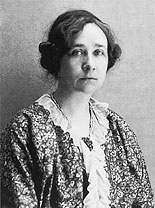Gabriele Münter, the well-known painter of “Der Blaue Reiter,” was also a gifted graphic artist, capable of translating her pictorial ideas into a clear linear framework. One can positively term her ability to capture impressions of the external world in simple, sketch-like structures a fundamental element of her art. About her much better-known works in oil paint, she herself even remarked: “He who looks attentively at my paintings will find the draughtsman in them. Despite all the colouration, a fixed drawn framework is there.”
This special gift for the analytical structuring of a pictorial impression through lines and surfaces, which was in harmony with the revolutionary renewals of modern art after the turn of the twentieth century, allowed Münter to become one of the outstanding draughtswomen of High Modernism.
At the same time, this talent destined her to work with print techniques, of which the two early pieces from 1907 shown here are exemplary specimens. The gouache “Autumn at Sèvres,” in white on a dark ground, is a preparatory work for the highly demanding coloured linoleum cut of the same name, one of the prints which Münter would bring to an astonishing level of mastery in her early Parisian period. Also made at Sèvres, the coloured linoleum cut “Kandinsky at the Harmonium,” in which she characteristically captured the essence of her companion, is among her extremely rare outstanding early prints and exists in only a few proofs (cat. 1, 2).
The majority of the subsequent watercolours and brush drawings are dedicated to the landscape of her beloved Alpine foothills around Murnau and Garmisch-Partenkirchen, to which she returned in the early 1920’s, after the years of the “Blauer Reiter” and the painful separation from Kandinsky during the First World War. Characteristic for her is the “fixed drawn framework” with which she captures each motif as the sum of broadly seen impressions. These lines reproduce the hidden rhythm of the expressively coloured compositions, at times delicately, as in “Morning Shadows” (cat. 3) or “View across Lake Staffel” (cat. 6), at times more powerfully and expressively, as in “Landscape with Farm” (cat. 5), “Two Trees Near Murnau” (cat. 7) or “Murnau at the Harvest” (cat. 8). Their manner recalls Kandinsky’s lovely homage to Münter’s art: “your balancing line and your sense of colour.”
Annegret Hoberg
(Curator of the “Blauer Reiter” Collection and Kubin Archive at the Lenbachhaus, Munich)
The provenance for this exemplary group of works on paper, characteristic of Gabriele Münter’s various creative periods, can be traced directly back to the artist, as all of the sheets were originally part of her personal estate. The majority of the watercolours bear the stamp of the Gabriele Münter- and Johannes Eichner-Foundation on the verso (not in Lugt).
